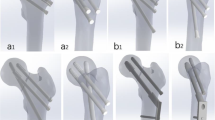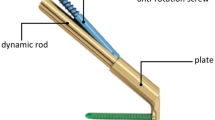Abstract
Verticality of transcervical hip fractures in young patients is usually connected with typically high-energy fractures which are known as Pauwels type III. Artificial femoral head replacement surgery is mostly not considered for treating femoral neck fractures in such patients. The commonly used devices for the fixation of vertical femoral neck fractures are multiple screws or a sliding hip screw with or without an antirotation screw. Size, location and length of the screws are the most effective parameters in terms of the structural performance of internal fixation implants, but the optimal configuration of the screws is necessary to be investigated to direct the clinical practice. The aim of this study is to compare the biomechanical stability of the standard inverted triangle configuration with the various newly proposed x-crossed screw configurations. FEA simulations carried out in this study demonstrated that using an x-crossed-right assembly in treating Pauwels type III femoral neck fractures satisfies the biomechanical stability in terms of maximum von Mises stresses and maximum femoral head displacement. However, in terms of maximum relative neck fracture displacement, the x-crossed-right assembly would not entirely suffice the desired biomechanical stability. Therefore, using an x-crossed screw assembly in treating femoral neck fractures would provide the needed biomechanical stability.
Graphical Abstract









Similar content being viewed by others
References
Gao Z, Wang M, Shen B, Chu X, Ruan D (2021) Treatment of Pauwels type III femoral neck fracture with medial femoral neck support screw: a biomechanical and clinical study. Sci Rep 11(1):21418
Sheehan SE, Shyu JY, Weaver MJ, Sodickson AD, Khurana B (2015) Proximal femoral fractures: what the orthopedic surgeon wants to know. Radiographics 35(5):1563–84
Collinge CA, Mir H, Reddix R (2014) Fracture morphology of high shear angle “vertical” femoral neck fractures in young adult patients. J Orthop Trauma 28(5):270–275
Shen M, Wang C, Chen H, Rui Y-F, Zhao S (2016) An update on the Pauwels classification. J Orthop Surg Res 11(1):161
Enocson A, Lapidus LJ (2012) The vertical hip fracture - a treatment challenge. A cohort study with an up to 9 year follow-up of 137 consecutive hips treated with sliding hip screw and antirotation screw. BMC Musculoskelet Disord 13(1):171
Corderio M, Caskey S, Frank C, Martin S, Srivastava A, Atkinson T (2020) Hybrid triad provides fracture plane stability in a computational model of a Pauwels type III hip fracture. Comput Methods Biomech Biomed Engin. https://doi.org/10.1080/10255842.2020.1738404
Hoshino CM, Christian MW, O’Toole RV, Manson TT (2016) Fixation of displaced femoral neck fractures in young adults: fixed-angle devices or Pauwel screws? Injury 47(8):1676–1684
Zhou L, Lin J, Huang A, Gan W, Zhai X, Sun K, Huang S, Li Z (2020) Modified cannulated screw fixation in the treatment of Pauwels type III femoral neck fractures: a biomechanical study. Clin Biomech 74:103–110
Gjertsen JE, Vinje T, Engesaeter LB, Lie SA, Havelin LI, Furnes O, Fevang JM (2010) Internal screw fixation compared with bipolar hemiarthroplasty for treatment of displaced femoral neck fractures in elderly patients. J Bone Joint Surg Am 92(3):619–628
Fischer H, Maleitzke T, Eder C, Ahmad S, Stöckle U, Braun KF (2021) Management of proximal femur fractures in the elderly: current concepts and treatment options. Eur J Med Res 26(1):86
Filipov O, Stoffel K, Gueorguiev B, Sommer C (2017) Femoral neck fracture osteosynthesis by the biplane double-supported screw fixation method (BDSF) reduces the risk of fixation failure: clinical outcomes in 207 patients. Arch Orthop Trauma Surg. https://doi.org/10.1007/s00402-017-2689-8
Yang JJ, Lin LC, Chao KH, Chuang SY, Wu CC, Yeh TT, Lian YT (2013) Risk factors for nonunion in patients with intracapsular femoral neck fractures treated with three cannulated screws placed in either a triangle or an inverted triangle configuration. J Bone Joint Surg Am 95:61–69
Gurusamy K, Parker MJ, Rowlands TK (2005) The complications of displaced intracapsular fractures of the hip: the effect of screw positioning and angulation on fracture healing. J Bone Joint Surgery Br 87:632–634
Haidukewych GJ, Rothwell WS, Jacofsky DJ, Torchia ME, Berry DJ (2004) Operative treatment of femoral neck fractures in patients between the ages of fifteen and fifty years. J Bone Joint Surg Am 86-A:1711–6
Enocson A, Lapidus LJ (2012) The vertical hip fracture – a treatment challenge. A cohort study with an up to 9 year follow-up of 137 consecutive hips treated with sliding hip screw and antirotation screw. BMC Musculoskelet Disord 13:171
Mei J, Liu S, Jia G, Cui X, Jing C, Ou Y (2014) Finite element analysis of the effect of cannulated screw placement and drilling frequency on femoral neck fracture fixation. Injury 45(12):2045–2050
Özkal FM, Cakir F, Sensoz E (2020) Schematization of cannulated screw fixations in femoral neck fractures using genetic algorithm and finite element method. J Med Biol Eng 40:673–687
Li T, Peng Y, Jingli X, QuiShi W, GuangQuan Z, Wei H, Qingwen Z (2018) Finite element analysis of different configurations of fully threaded cannulated screw in the treatment of unstable femoral neck fractures. Biomed Pharmacother :112. https://doi.org/10.1016/j.biopha.2019.108658
Lee PY, Chen YN, Hu JJ, Chang CH (2018) Comparison of mechanical stability of elastic titanium, nickel-titanium, and stainless steel nails used in the fixation of diaphyseal long bone fractures. Materials 11(11):2159. https://doi.org/10.3390/ma11112159
Rho JY, Ashman RB, Turner CH (1993) Young’s modulus of trabecular and cortical bone material: ultrasonic and microtensile measurements. J Biomech 26(2):111–119
Hoffmeister BK, Smith SR, Handley SM, Rho JY (2000) Anisotropy of Young’s modulus od human tibial cortical bone. Med Biol Eng Comput 38:333–338
Li J, Wang M, Zhou J, Han L, Zhang H, Li C, Li L, Hao M (2018) Optimum configuration of cannulated compression screws for the fixation of unstable femoral neck fractures: finite element analysis evaluation. Biomed Res Int. https://doi.org/10.1155/2018/1271762
Denham RA (1959) HIP mechanics. J Bone Joint Surg Br 41-B(3):550–557
Fryar CD, Gu Q, Ogden CL, Flegal KM (2016) Anthropometric reference data for children and adults: United States, 2011–2014. Vital Health Stat 3(39):1–46
Crowell RR, Edwards WT, Hayes WC (1985) Pullout strength of fixation devices in trabecular bone of the femoral head. Trans 31st Orthop Res Soc 10
Benterud JG, Husby T, Graadahl Ø, Alho A (1992) Implant holding power of the femoral head: a cadaver study of fracture screws. Acta Orthop 63(1):47–49
He D, Xue Y, Li Z, Tang Y, Ding H, Yang Z, Zhang C, Zhou H, Zhao Y, Zong Y (2014) Effect of depression on femoral head avascular necrosis from femoral neck fracture in patients younger than 60 years. Orthopedics 37:244–251
Perren SM (1979) Physical and biological aspects of fracture healing with special reference to internal fixation. Clin Othop Relat Res 138:175–196
Giannoudis PV, Jones E, Einhorn TA (2011) Fracture healing and bone repair. Injury 42:549–550
Sfeir C, Ho L, Doll BA, Azari K, Hollinger JO (2005) Fracture repair. In: Lieberman JR, Friedlaender GE (eds) Bone regeneration and repair: biology and clinical applications. NJ. Humana Press, Totowa, pp 21–43
Gautier E, Ganz K, Krugel N, Gill T, Ganz R (2000) Anatomy of the medial femoral circumflex artery and its surgical implications. J Bone Joint Surg Br 82:679–683. https://doi.org/10.1302/0301-620X.82B5.10426
Lazaro LE, Klinger CE, Sculco PK, Helfet DL, Lorich DG (2015) The terminal branches of the medial femoral circumflex artery: the arterial supply of the femoral head. Bone Joint J 97-B:1204–1213. https://doi.org/10.1302/0301-620X.97B9.34704
Tianye L, Peng Y, Jingli X, QuiShi W, GuangQuan Z, Wei H, Qingwen Z (2019) Finite element analysis of different internal fixation methods for the treatment of Pauwels type III femoral neck fracture. Biomed Pharmacother 112:108658
Samsami S, Saberi S, Sadighi S, Rouhi G (2015) Comparison of three fixation methods for femoral neck fracture in young adults: experimental and numerical investigations. J Med Biol Eng 35:566–579. https://doi.org/10.1007/s40846-015-0085-9
Hoshino CM, Christian MW, O’Toole RV, Manson TT (2016) Fixation of displaced femoral neck fractures in young adults: fixed-angle devices or Pauwel screws? Injury 47:1676–1684
Hoshino CM, O’Toole RV (2015) Fixed angle devices versus multiple cancellous screws: what does the evidence tell us? Injury 46:474–477
Slobogean GP, Sprague SA, Scott T, McKee M, Bhandari M (2015) Management of young femoral neck fractures: is there a consensus? Injury 46:435–440
Madyira DM, Laubscher RF, Janse van Rensburg N, Henning PFJ (2013) High speed machining induced residual stresses in grade 5 titanium alloy. P I Mech Eng L-J Mat 227:208. https://doi.org/10.1177/1464420712462319
Blažević D, Kodvanj J, Adamović P, Vidović D, Trobonjača Z, Sabalić S (2022) Comparison between external locking plate fixation and conventional external fixation for extraarticular proximal tibial fractures: a finite element analysis. J Orthop Surg Res 17:16. https://doi.org/10.1186/s13018-021-02907-3
Stoffel K, Zderic I, Gras F, Sommer C, Eberli U, Mueller D, Oswald M, Gueorguiev B (2017) Biomechanical evaluation of the femoral neck system in unstable Pauwels III femoral neck fractures: a comparison with the dynamic hip screw and cannulated screws. J Orthop Trauma 31(3):131–137
Inzana JA, Varga P, Windolf M (2016) Implicit modeling of screw threads for efficient finite element analysis of complex bone-implant systems. J Biomech :1836–1844
Jiang D, Zhan S, Wang L, Shi LL, Ling M, Hu H, Jia W (2020) Biomechanical comparison of five cannulated screw fixation strategies for young vertical femoral neck fractures. A patient-specific finite element analysis. J Orthop Res. https://doi.org/10.1002/jor.24881
Author information
Authors and Affiliations
Corresponding author
Ethics declarations
Ethics approval
Not required.
Conflict of interest
The authors declare no competing interests.
Additional information
Publisher's note
Springer Nature remains neutral with regard to jurisdictional claims in published maps and institutional affiliations.
Rights and permissions
Springer Nature or its licensor (e.g. a society or other partner) holds exclusive rights to this article under a publishing agreement with the author(s) or other rightsholder(s); author self-archiving of the accepted manuscript version of this article is solely governed by the terms of such publishing agreement and applicable law.
About this article
Cite this article
Adamović, P., Kodvanj, J., Blažević, D. et al. Novel screw fixation placement configuration for the treatment of Pauwels type III femoral neck fractures: a finite element analysis. Med Biol Eng Comput 61, 1005–1015 (2023). https://doi.org/10.1007/s11517-023-02771-9
Received:
Accepted:
Published:
Issue Date:
DOI: https://doi.org/10.1007/s11517-023-02771-9




